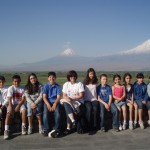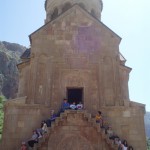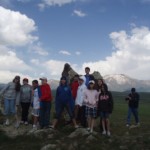Friday, May 29, 2009
We all woke up happily (and a little early) from partying last night at the May 28 celebration. Now, our class is heading to Artsakh. We are going to stay there for a few days. We have several stopping point on our way to Artsakh, including Khor Virab, Noravank, and Karahunge.
On our way to Khor Virab we saw the Gomidas Pantheon, where many important Armenians are buried (for example: Gomidas, William Saroyan, and Aram Khachatourian among others). One interesting place we passed by was the rubber factory. It was where people make rubber. Then, we entered Ararat Valley where it is the center of Armania’s agricultural prodcution. But, the most beautiful place we saw was Mt. Ararat. It was the clearest view of the mountain I had ever seen! The class and the parents took many pictures in front of Mt. Ararat, in Khor Virab. We also learned that the mountain range is called Armenian Dance (Haygagan Shourchbar), because it looks like Mt. Ararat is dancing.
Finally, we arrived at Khor Virab, where we passed by Kevork Chavoosh’s statue (an Armenian Hero). Khor Virab means deep dungeon and it was where Krikor Loosavorich (the Illuminator) was thrown into by King Drtat because he converted into Christianity. Krikor lived in the dungeon for 13 years, but he survived because Khosrovitookht (King Drtat’s sister) fed Krikor everyday because, she was secretly conveterd into Christianity as well. The dungeon was dark and a deep (6 meters) and narrow (4 meters). I imagine that Krikor spent a difficult and sad time there. In the year 301, King Drtad became very sick. Khosrovitookht had an illusion that Krikor could help cure King Drtad. Krikor succeeded in curing him. In the same year, King Drtad released Krikor and got baptized and accepted Christianity. Armenia was the first country in the world to become Christian.
After we left Khor Virab, we headed towards Noravank, a 13th century monastery. On our way there, we saw a very interesting street. It was where a lot of storks lived and built nests on top of electrical poles. We saw the street that Barouyr Sevag had his accident and later passed by his home village. Barouyr Sevag was a famous Armenian poem, who wrote about the Genocide and how the Turks killed and deported the Armenians. Lastly, the scenery (on our way to Noravank) was awesome! We passed by a lot of lush green and grassy mountains. It looked like the grass was a long green rug.
Finally we arrived at Noravank! There are 3 churches in Noravank; Boortel Ishkhan church, St. Garabed church and St. Krikor Madoor (chapel). Boortel Ishkhan was founded in the 13th century by Momig, the architect. Momig built this church because he fell in love with Boortel’s daughter, a princess. In order to have the permission to marry the princess, Momig had to build a very nice temple in three years time, without anyone’s help. This order was given by, the princess’s father, Boortel Ishkhan (who this church is named after). So, Momig started working right away, years passed… It was finally time to put the last brick down. But, Boortel Ishkhan had already ordered one of his servants to kill Momig, because he did not want Momig, a peasant, to marry his daughter. So, as the legend goes, Momig did not get to put the last brick on the temple, but the stone was used as his tomb stone. Boortel Ishkhan temple represents earth, life and heaven.
St. Garabed was built in the 13th century (started in 1216 and completed in 1226). This church was made by Sinan. In this church you have permission to step on other people’s gravestones, because, everyone is equal when they are up in heaven and that the servants still survive. St. Krikor Madoor was built in 1273 and finished in 1275.This church was also made by Seran. There is a secret in this church. Sinan made the window opening such that every year from August 6-13, the sun falls into the church in the sign of the cross on Krikor’s gravestone. St. Krikor Madoor is an example of brotherhood. An important difference of the church complex is that it does not have any bell tower.
When we arrived at Karahunge, a stonehenge that dates back to 5000 B.C., we saw some of the rocks that were designed and built in the early Bronze Age. The rocks had many interesting features on them and were used as some sort of observatory. There were holes on the stones to locate the stars and galaxies at that time. There was also a round temple in the center of the field, dedicated to the God of Sun, Arin.
On our way, we passed by many villages and towns, the larger ones being Goris and Sisian. The scenery was unforgettable.
Finally we arrived at Artsakh! The view at Artsakh was great. It was different than the view in Yerevan because, it has very green and beautiful mountains. We passed by many mountain passes and had to drive through fog in the last stretch. We saw many rivers and gorges and caves. We passed the city of Shushi and saw the capital city of Stepanakert in the valley. After arriving there, we all had dinner and went to bed with wonderful memories.
Soleen Ghahraman


